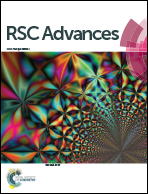Different mechanisms of ultrafast excited state deactivation of coumarin 500 in dioxane and methanol solvents: experimental and theoretical study†
Abstract
Solute–solvent intermolecular photoinduced intramolecular charge transfer (ICT) and twisted intramolecular charge transfer (TICT) states are proposed to account for the unusual properties of coumarin 500 (C500) in 1,4-dioxane (Diox) and methanol (MeOH) solvents. Our femtosecond transient absorption experiment on C500 shows that in Diox, there exists a single exponential component with a time constant of τ1 ∼ 1.4 ps, however in MeOH two exponential components with lifetimes of τ1 ∼ 0.5 ps and τ2 ∼ 8.0 ps are observed. DFT and TDDFT methods were used to optimize the geometries of complexes C500–Diox and C500–(MeOH)3 in the ground and excited states, respectively. They show that the rapid decay time could be due to ICT and ICT → TICT could be responsible for the slow decay time. Strengthening of the hydrogen bond N–H⋯O–H and the weakening of the hydrogen bond N⋯H–O in the excited state of the C500–(MeOH)3 complex could facilitate the process of ICT from the 7-NHEt group to the CF3 group and induce the formation of the TICT state in hydrogen bonding with MeOH. Together, the experimental and theoretical results reveal that C500 exhibits unusual deactivation mechanisms in Diox and MeOH solvents.


 Please wait while we load your content...
Please wait while we load your content...